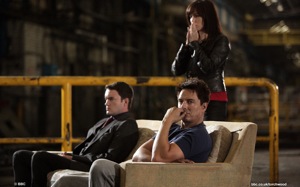A magazine where the digital world meets the real world.
On the web
- Home
- Browse by date
- Browse by topic
- Enter the maze
- Follow our blog
- Follow us on Twitter
- Resources for teachers
- Subscribe
In print
What is cs4fn?
- About us
- Contact us
- Partners
- Privacy and cookies
- Copyright and contributions
- Links to other fun sites
- Complete our questionnaire, give us feedback
Search:
Torchwood: in need of some backup
Disaster planning, that’s the Torchwood game. They are there to save the Earth whenever it needs saving from aliens (which is every week). Shame they blew it when it came to disaster planning for Torchwood itself!
We are coming
Torchwood is the BBC’s cult spin-off from Doctor Who. In the series, Children of the Earth, the world is threatened by the mysterious and brutal ‘456’ whose arrival is heralded when every child in the world simultaneously stops in their tracks and chants ‘We are coming’. The Torchwood team of Captain Jack Harkness, Gwen Cooper and Ianto Jones once more spring into action. Unfortunately, early on a little accident (we won’t say what so as not to spoil it) happens in their base buried under Cardiff. On the run and homeless, for a while they have only their wits in place of the normal hi-tech surveillance gadgetry. It’s so desperate at one point, they end up in an empty shell of a warehouse with only a sofa and the contents of their pockets with which to save the world.
Move it!
It’s such a shame that it comes to this when a little bit of disaster planning would have made it all so much easier to beat the aliens. A backup site is crucial in plans for a disaster, whether earthquake or Martian hordes. Just because your home city has been hit by a tsunami or flattened to the ground by a meteorite doesn’t mean your operations have to be disrupted.
Captain Jack knows all about disaster management of course. Kill him, and after a brief period of pain he jolts back to life and carries on as though nothing has happened. With some standard forward planning any organisation can operate just like that too.
The fact that when the disaster happens the Torchwood team have to come up with solutions on the fly shows that they not only had no backup, but hadn’t even thought about it. Tut tut!
If they had done some planning, what would have been their alternatives?

Cold war
The first alternative, for those organisations that need to survive a disaster is to have a ‘cold site’ ready. In fact this is what Torchwood defaulted to in their warehouse. Lucky Ianto remembered it! A cold site is just a backup location that can be moved in to. It doesn’t have software, data or even hardware ready, but at least everyone knows what to do and where to go. In time it can be up and running again. Clearly given their remit of saving the Earth against war-hungry aliens, Torchwood needed something better than that.
Getting warmer
At the other end of the disaster planning spectrum is the ‘hot site’. It is a fully functioning copy of your main operations building. All the hardware is there, the software is there and so is the data. Everything that happens at the main site IT-wise is copied at the hot site too. Lose your main site to a nuclear bomb and you just carry on almost seamlessly at the hot site. (It obviously has to be located somewhere else suitably far away, not just next door, or it too will be as radioactively hot as the original and be of little use). You can also have ‘warm sites’ of different degrees where for example you just have the hardware installed, or the data backups are only weekly rather than continuously.
Which kind of backup site is chosen depends on the organisation: what can it afford balanced against the costs of downtime (and how much down time the business can take and still survive). If it is critical to the survival of the planet, like Torchwood, then clearly you need to be at the warmer end of the backup scale!
Back to life
It’s a shame then that Torchwood’s IT management only focused on installing lots of fancy gadgets and ignored the more mundane side of things. If they had been a little more competent Jack and co might have sorted out the ‘456’ before it all got out of hand. Never mind. It all worked out OK in the end. Well, sort of.
Torchwood image copyright © BBC



